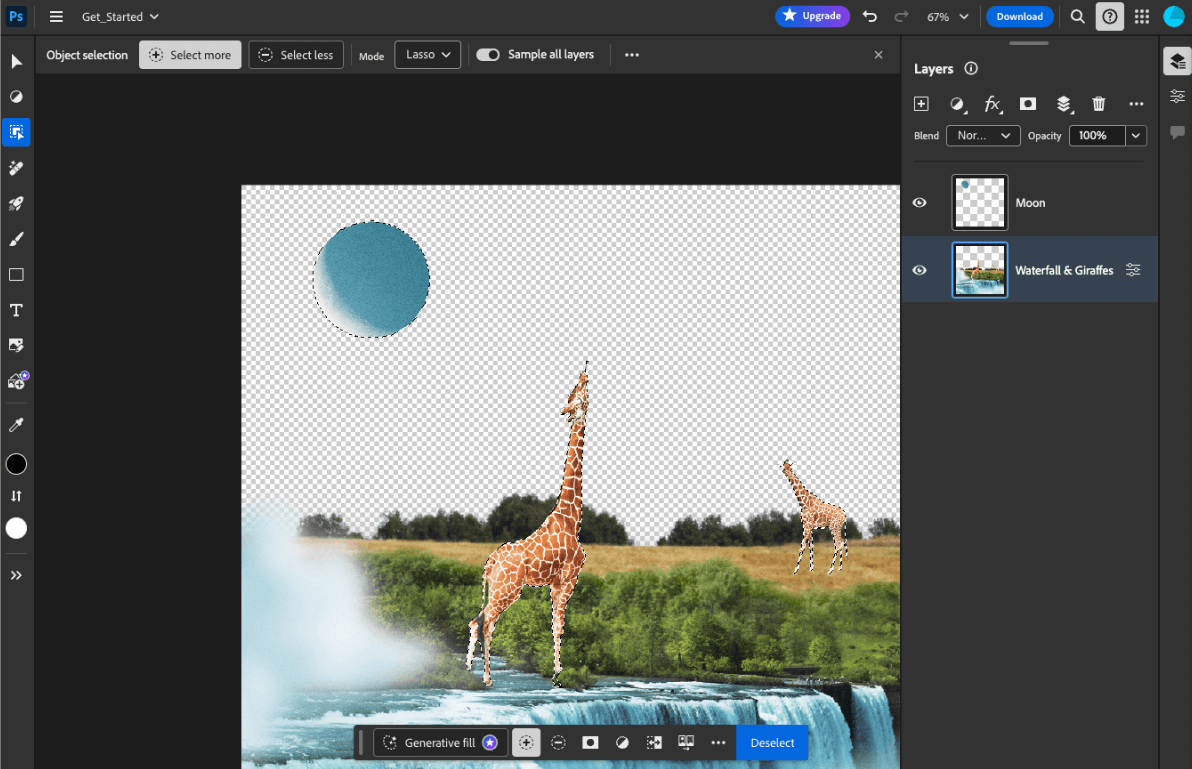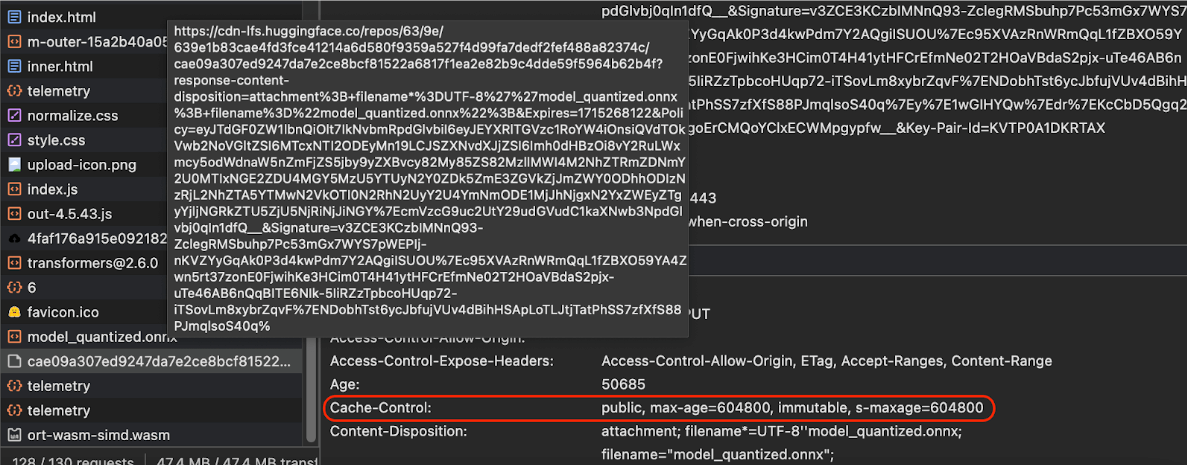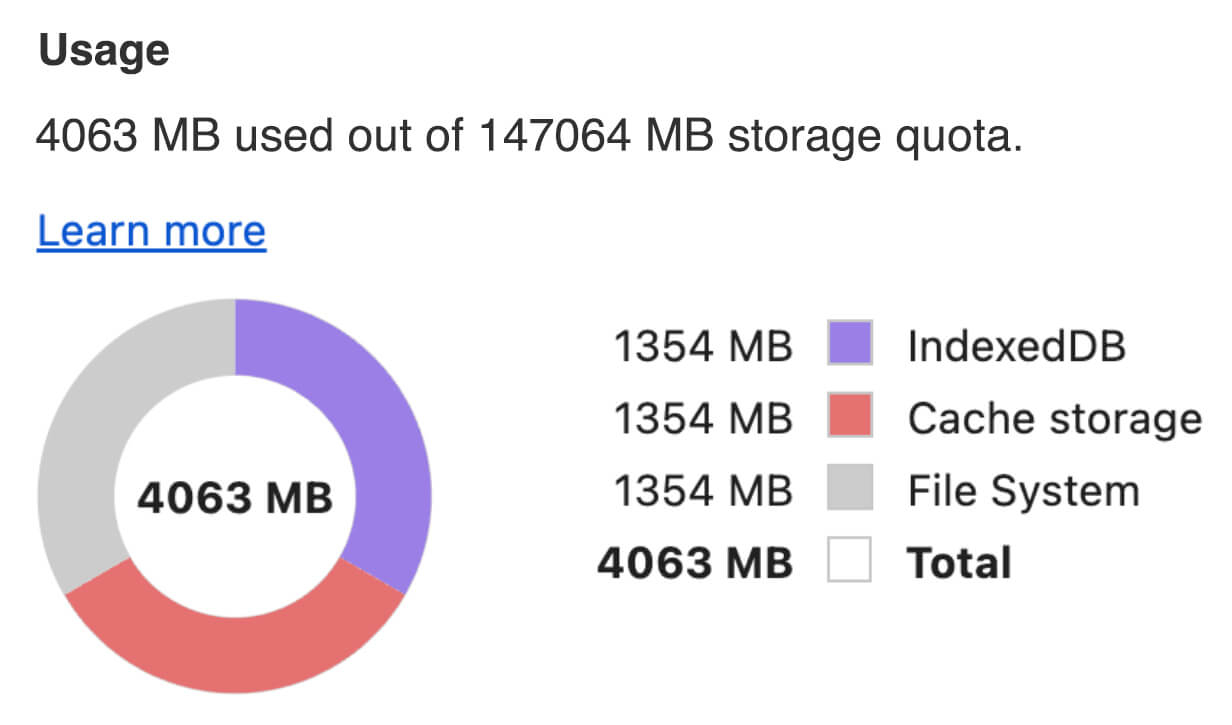ほとんどの言語モデルには、インターネット経由で転送されるリソースとしてはかなり大きいという共通点があります。最小の MediaPipe オブジェクト検出モデル(SSD MobileNetV2 float16)のサイズは 5.6 MB で、最大は約 25 MB です。
オープンソースの大規模言語モデル(LLM)である gemma-2b-it-gpu-int4.bin は 1.35 GB で、LLM としては非常に小さいとされています。生成 AI モデルは非常に大規模になる可能性があります。そのため、今日の AI の使用の多くはクラウドで行われています。アプリは、高度に最適化されたモデルをデバイス上で直接実行するようになっています。ブラウザで実行される LLM のデモはありますが、ブラウザで実行される他のモデルのプロダクション グレードの例をいくつか紹介します。

- Adobe Photoshop は、インテリジェントなオブジェクト選択ツールで
Conv2Dモデルのバリアントをデバイス上で実行します。 - Google Meet の背景ぼかし機能では、人物のセグメンテーションに最適化されたバージョンの
MobileNetV3-smallモデルが使用されています。 - Tokopedia は、サービスの無効な登録を防ぐために、リアルタイムの顔検出に
MediaPipeFaceDetector-TFJSモデルを使用しています。 - Google Colab では、ユーザーは Colab ノートブックでハードディスクのモデルを使用できます。
アプリの今後の起動を高速化するには、暗黙的な HTTP ブラウザ キャッシュに依存するのではなく、モデルデータを明示的にデバイスにキャッシュ保存する必要があります。
このガイドでは gemma-2b-it-gpu-int4.bin モデルを使用してチャットボットを作成していますが、このアプローチは、他のモデルやオンデバイスの他のユースケースに合わせて一般化できます。アプリをモデルに接続する最も一般的な方法は、アプリのリソースとともにモデルをサービングすることです。配信を最適化することが重要です。
適切なキャッシュ ヘッダーを構成する
サーバーから AI モデルをサービングする場合は、正しい Cache-Control ヘッダーを構成することが重要です。次の例は、アプリのニーズに合わせて構築できる堅牢なデフォルト設定を示しています。
Cache-Control: public, max-age=31536000, immutable
リリースされた AI モデルの各バージョンは静的リソースです。変更されないコンテンツには、リクエスト URL でのキャッシュ バスティングと組み合わせて、長い max-age を指定する必要があります。モデルを更新する必要がある場合は、新しい URL を指定する必要があります。
ユーザーがページを再読み込みすると、サーバーがコンテンツの安定性を認識しているにもかかわらず、クライアントは再検証リクエストを送信します。immutable ディレクティブは、コンテンツが変更されないため再検証が不要であることを明示的に示します。immutable ディレクティブは、ブラウザや中間キャッシュ サーバー、プロキシ サーバーでは広くサポートされていませんが、広く理解されている max-age ディレクティブと組み合わせることで、最大限の互換性を確保できます。public レスポンス ディレクティブは、レスポンスを共有キャッシュに保存できることを示します。

Cache-Control ヘッダーが表示されます。(出典)
AI モデルをクライアント サイドでキャッシュに保存する
AI モデルをサービングする場合は、ブラウザでモデルを明示的にキャッシュに保存することが重要です。これにより、ユーザーがアプリを再読み込みした後もモデルデータをすぐに利用できるようになります。
これにはさまざまな手法を使用できます。次のコードサンプルでは、各モデルファイルがメモリ内の blob という名前の Blob オブジェクトに保存されているとします。
パフォーマンスを理解するために、各コードサンプルには performance.mark() メソッドと performance.measure() メソッドのアノテーションが付いています。これらの測定はデバイスに依存しており、一般化できません。

次の API のいずれかを使用して、ブラウザで AI モデルをキャッシュに保存できます。Cache API、Origin Private File System API、IndexedDB API。一般的には Cache API の使用をおすすめしますが、このガイドではすべてのオプションのメリットとデメリットについて説明します。
Cache API
Cache API は、長期間メモリにキャッシュ保存される Request オブジェクトと Response オブジェクトのペアに永続ストレージを提供します。この API は、Service Workers 仕様で定義されていますが、メインスレッドまたは通常のワーカーから使用できます。サービス ワーカー コンテキスト外で使用するには、Request オブジェクトの代わりに合成 URL とペア設定された合成 Response オブジェクトを使用して、Cache.put() メソッドを呼び出します。
このガイドでは、インメモリ blob を前提としています。偽の URL をキャッシュキーとして使用し、blob に基づいて合成 Response を使用します。モデルを直接ダウンロードする場合は、fetch() リクエストの作成で取得した Response を使用します。
たとえば、Cache API を使用してモデルファイルを保存して復元する方法は次のとおりです。
const storeFileInSWCache = async (blob) => {
try {
performance.mark('start-sw-cache-cache');
const modelCache = await caches.open('models');
await modelCache.put('model.bin', new Response(blob));
performance.mark('end-sw-cache-cache');
const mark = performance.measure(
'sw-cache-cache',
'start-sw-cache-cache',
'end-sw-cache-cache'
);
console.log('Model file cached in sw-cache.', mark.name, mark.duration.toFixed(2));
} catch (err) {
console.error(err.name, err.message);
}
};
const restoreFileFromSWCache = async () => {
try {
performance.mark('start-sw-cache-restore');
const modelCache = await caches.open('models');
const response = await modelCache.match('model.bin');
if (!response) {
throw new Error(`File model.bin not found in sw-cache.`);
}
const file = await response.blob();
performance.mark('end-sw-cache-restore');
const mark = performance.measure(
'sw-cache-restore',
'start-sw-cache-restore',
'end-sw-cache-restore'
);
console.log(mark.name, mark.duration.toFixed(2));
console.log('Cached model file found in sw-cache.');
return file;
} catch (err) {
throw err;
}
};
Origin Private File System API
オリジン プライベート ファイル システム(OPFS)は、ストレージ エンドポイントの比較的新しい標準です。ページのオリジンに限定されるため、通常のファイル システムとは異なり、ユーザーには表示されません。パフォーマンス向けに高度に最適化された特別なファイルへのアクセスを提供し、そのコンテンツへの書き込みアクセスを許可します。
たとえば、OPFS でモデルファイルを保存して復元する方法は次のとおりです。
const storeFileInOPFS = async (blob) => {
try {
performance.mark('start-opfs-cache');
const root = await navigator.storage.getDirectory();
const handle = await root.getFileHandle('model.bin', { create: true });
const writable = await handle.createWritable();
await blob.stream().pipeTo(writable);
performance.mark('end-opfs-cache');
const mark = performance.measure(
'opfs-cache',
'start-opfs-cache',
'end-opfs-cache'
);
console.log('Model file cached in OPFS.', mark.name, mark.duration.toFixed(2));
} catch (err) {
console.error(err.name, err.message);
}
};
const restoreFileFromOPFS = async () => {
try {
performance.mark('start-opfs-restore');
const root = await navigator.storage.getDirectory();
const handle = await root.getFileHandle('model.bin');
const file = await handle.getFile();
performance.mark('end-opfs-restore');
const mark = performance.measure(
'opfs-restore',
'start-opfs-restore',
'end-opfs-restore'
);
console.log('Cached model file found in OPFS.', mark.name, mark.duration.toFixed(2));
return file;
} catch (err) {
throw err;
}
};
IndexedDB API
IndexedDB は、ブラウザで任意のデータを永続的に保存するための確立された標準です。やや複雑な API で知られていますが、idb-keyval などのラッパー ライブラリを使用すると、IndexedDB を従来のキー値ストアのように扱うことができます。
次に例を示します。
import { get, set } from 'https://cdn.jsdelivr.net/npm/idb-keyval@latest/+esm';
const storeFileInIDB = async (blob) => {
try {
performance.mark('start-idb-cache');
await set('model.bin', blob);
performance.mark('end-idb-cache');
const mark = performance.measure(
'idb-cache',
'start-idb-cache',
'end-idb-cache'
);
console.log('Model file cached in IDB.', mark.name, mark.duration.toFixed(2));
} catch (err) {
console.error(err.name, err.message);
}
};
const restoreFileFromIDB = async () => {
try {
performance.mark('start-idb-restore');
const file = await get('model.bin');
if (!file) {
throw new Error('File model.bin not found in IDB.');
}
performance.mark('end-idb-restore');
const mark = performance.measure(
'idb-restore',
'start-idb-restore',
'end-idb-restore'
);
console.log('Cached model file found in IDB.', mark.name, mark.duration.toFixed(2));
return file;
} catch (err) {
throw err;
}
};
ストレージを永続化済みとしてマークする
これらのキャッシュ保存メソッドのいずれかの最後に navigator.storage.persist() を呼び出して、永続ストレージの使用権限をリクエストします。このメソッドは、権限が付与されている場合は true に、それ以外の場合は false に解決される Promise を返します。ブラウザ固有のルールに応じて、ブラウザはリクエストを尊重する場合としない場合があります。
if ('storage' in navigator && 'persist' in navigator.storage) {
try {
const persistent = await navigator.storage.persist();
if (persistent) {
console.log("Storage will not be cleared except by explicit user action.");
return;
}
console.log("Storage may be cleared under storage pressure.");
} catch (err) {
console.error(err.name, err.message);
}
}
特殊なケース: ハードディスク上のモデルを使用する
ブラウザ ストレージの代わりに、ユーザーのハードディスクから AI モデルを直接参照できます。この手法は、研究に特化したアプリでブラウザで特定のモデルを実行できることを示すのに役立ちます。また、アーティストが専門的なクリエイティブ アプリで自己トレーニングしたモデルを使用することもできます。
File System Access API
File System Access API を使用すると、ハードディスクからファイルを開き、IndexedDB に永続化できる FileSystemFileHandle を取得できます。
このパターンでは、ユーザーはモデルファイルへのアクセス権を 1 回だけ付与する必要があります。永続的な権限により、ユーザーはファイルへのアクセス権を永続的に付与することを選択できます。アプリを再読み込みし、マウスのクリックなどの必要なユーザー操作を行うと、FileSystemFileHandle は IndexedDB から復元され、ハードディスク上のファイルにアクセスできるようになります。
ファイル アクセス権限はクエリされ、必要に応じてリクエストされるため、今後の再読み込みはシームレスに行われます。次の例は、ハードディスクからファイルのハンドルを取得し、そのハンドルを保存して復元する方法を示しています。
import { fileOpen } from 'https://cdn.jsdelivr.net/npm/browser-fs-access@latest/dist/index.modern.js';
import { get, set } from 'https://cdn.jsdelivr.net/npm/idb-keyval@latest/+esm';
button.addEventListener('click', async () => {
try {
const file = await fileOpen({
extensions: ['.bin'],
mimeTypes: ['application/octet-stream'],
description: 'AI model files',
});
if (file.handle) {
// It's an asynchronous method, but no need to await it.
storeFileHandleInIDB(file.handle);
}
return file;
} catch (err) {
if (err.name !== 'AbortError') {
console.error(err.name, err.message);
}
}
});
const storeFileHandleInIDB = async (handle) => {
try {
performance.mark('start-file-handle-cache');
await set('model.bin.handle', handle);
performance.mark('end-file-handle-cache');
const mark = performance.measure(
'file-handle-cache',
'start-file-handle-cache',
'end-file-handle-cache'
);
console.log('Model file handle cached in IDB.', mark.name, mark.duration.toFixed(2));
} catch (err) {
console.error(err.name, err.message);
}
};
const restoreFileFromFileHandle = async () => {
try {
performance.mark('start-file-handle-restore');
const handle = await get('model.bin.handle');
if (!handle) {
throw new Error('File handle model.bin.handle not found in IDB.');
}
if ((await handle.queryPermission()) !== 'granted') {
const decision = await handle.requestPermission();
if (decision === 'denied' || decision === 'prompt') {
throw new Error('Access to file model.bin.handle not granted.');
}
}
const file = await handle.getFile();
performance.mark('end-file-handle-restore');
const mark = performance.measure(
'file-handle-restore',
'start-file-handle-restore',
'end-file-handle-restore'
);
console.log('Cached model file handle found in IDB.', mark.name, mark.duration.toFixed(2));
return file;
} catch (err) {
throw err;
}
};
これらの方法は相互排他的ではありません。ブラウザでモデルを明示的にキャッシュに保存し、ユーザーのハードディスクからモデルを使用する場合があります。
デモ
MediaPipe LLM デモでは、3 つの通常のケース ストレージ方法とハードディスク方法が実装されています。
ボーナス: 大きなファイルをチャンクでダウンロードする
インターネットから大きな AI モデルをダウンロードする必要がある場合は、ダウンロードを個別のチャンクに並列化し、クライアントで再度結合します。
パッケージ fetch-in-chunks は、コードで使用できるヘルパー関数を提供します。url を渡すだけで済みます。maxParallelRequests(デフォルト: 6)、chunkSize(デフォルト: ダウンロードするファイルサイズを maxParallelRequests で割った値)、progressCallback 関数(downloadedBytes と合計 fileSize をレポート)、AbortSignal シグナルの signal はすべて省略可能です。
import fetchInChunks from 'fetch-in-chunks';
async function downloadFileWithProgress() {
try {
const blob = await fetchInChunks('https://example.com/largefile.zip', {
progressCallback: (downloaded, total) => {
console.log(`Downloaded ${((downloaded / total) * 100).toFixed(2)}%`);
},
});
return blob;
} catch (error) {
console.error('Error fetching file:', error);
}
}
downloadFileWithProgress();
自分に合った方法を選択する
このガイドでは、ブラウザで AI モデルを効果的にキャッシュに保存するさまざまな方法について説明しました。これは、アプリのパフォーマンスとユーザー エクスペリエンスを向上させるうえで重要なタスクです。Chrome ストレージ チームは、最適なパフォーマンスを実現するために Cache API を推奨しています。これにより、AI モデルへの迅速なアクセス、読み込み時間の短縮、応答性の向上が保証されます。
OPFS と IndexedDB は、あまり使いやすいオプションではありません。OPFS API と IndexedDB API は、データを保存する前にシリアル化する必要があります。IndexedDB は、データの取得時に逆シリアル化も行う必要があるため、大規模なモデルを保存する場所としては最適ではありません。
ニッチなアプリケーションの場合、File System Access API を使用すると、ユーザーのデバイス上のファイルに直接アクセスできます。これは、独自の AI モデルを管理するユーザーに最適です。
AI モデルを保護する必要がある場合は、サーバーに保存します。クライアントに保存されたデータは、デベロッパー ツールまたは OFPS デベロッパー ツール拡張機能を使用して、キャッシュと IndexedDB の両方から簡単に抽出できます。これらのストレージ API のセキュリティは本質的に同等です。モデルの暗号化バージョンを保存したくなるかもしれませんが、その場合は復号鍵をクライアントに取得する必要があります。この鍵は傍受される可能性があります。つまり、悪意のあるユーザーがモデルを盗もうとするのは少し難しくなりますが、不可能ではありません。
アプリの要件、ターゲット ユーザーの行動、使用する AI モデルの特性に合ったキャッシュ保存戦略を選択することをおすすめします。これにより、さまざまなネットワーク条件やシステム制約の下で、アプリケーションの応答性と堅牢性が確保されます。
謝辞
このドキュメントは、Joshua Bell、Reilly Grant、Evan Stade、Nathan Memmott、Austin Sullivan、Etienne Noël、André Bandarra、Alexandra Klepper、François Beaufort、Paul Kinlan、Rachel Andrew によってレビューされました。


